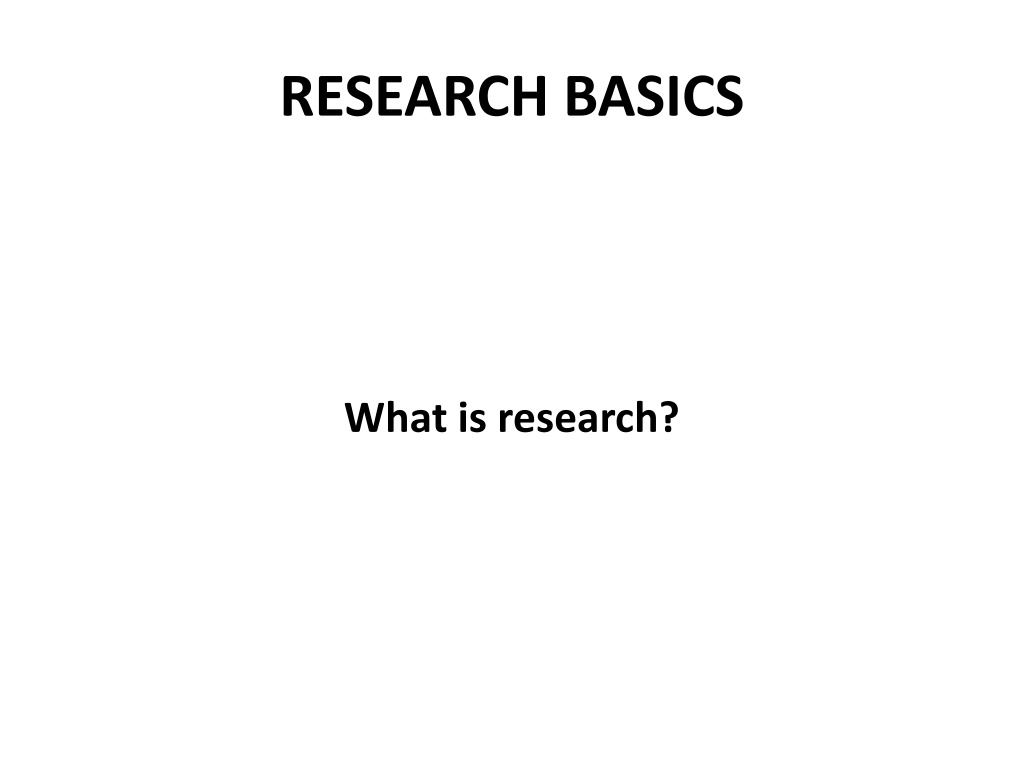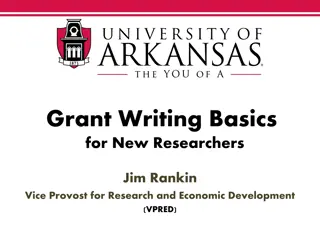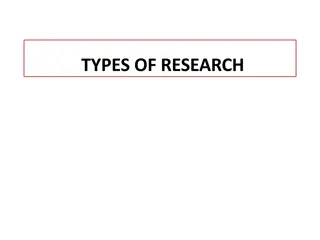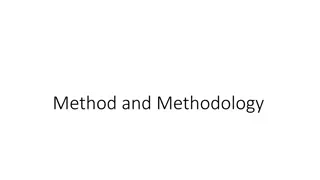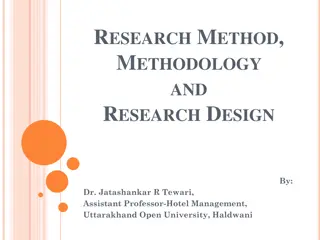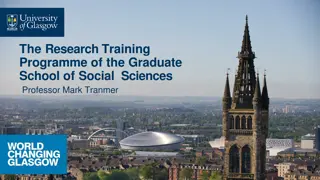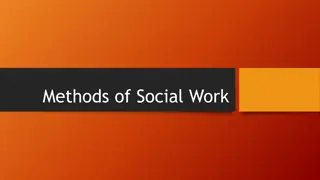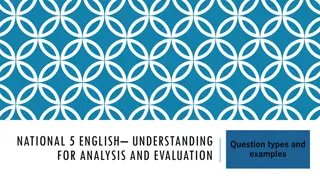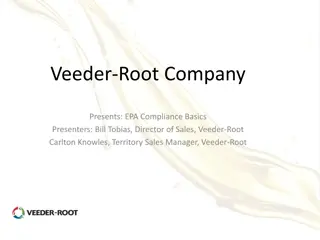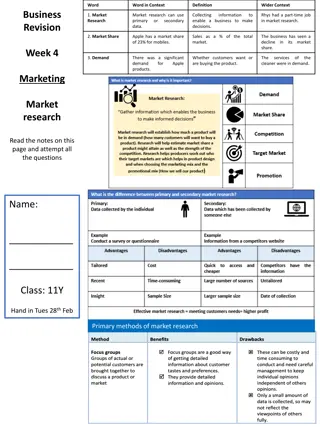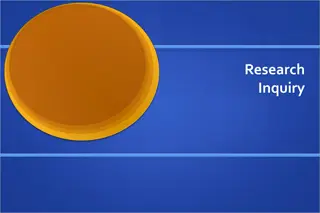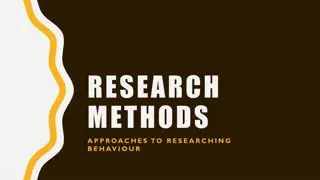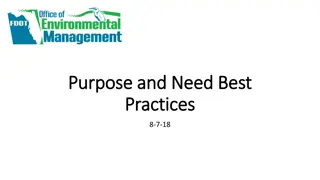Understanding Research: Basics, Purpose, and Methods
Research is a systematic process of inquiry, investigation, and discovery aimed at generating new knowledge, solving problems, and exploring existing situations. It involves utilizing various methods to collect and analyze information to draw meaningful conclusions. The purpose of research includes reviewing existing knowledge, providing solutions to problems, exploring general issues, and generating new knowledge. Research methods are essential tools used to carry out research effectively, helping to categorize, analyze, and synthesize information.
Download Presentation

Please find below an Image/Link to download the presentation.
The content on the website is provided AS IS for your information and personal use only. It may not be sold, licensed, or shared on other websites without obtaining consent from the author. Download presentation by click this link. If you encounter any issues during the download, it is possible that the publisher has removed the file from their server.
E N D
Presentation Transcript
RESEARCH BASICS What is research?
Research is a very general term for an activity that involves finding out, in a more or less systematic way, things you did not know. Research involves finding out about things that no-one else knew either.
RESEARCH IS a process of enquiry and investigation; it is systematic, methodical and ethical; research can help solve practical problems and increase knowledge.
THE PURPOSE OF RESEARCH IS TO Review or synthesize existing knowledge Investigate existing situations or problems Provide solutions to problems Explore and analyse more general issues Construct or create new procedures or systems Explain new phenomenon Generate new knowledge or a combination of any of the above! (Collis & Hussey, 2003)
Research methods are the techniques you use to do research. They represent the tools of the trade, and provide you with ways to collect, sort and analyse information so that you can come to some conclusions.
If you use the right sort of methods for your particular type of research, then you should be able to convince other people. Identifying a subject to research, finding and collecting information and analysing it, presents you with a range of practical problems that need to be solved.
The practice of research is closely bound up with the theoretical developments that were promoted by philosophers and key thinkers and practitioners in the sciences.
WHAT YOU CAN DO WITH RESEARCH Categorise. This involves forming a typology of objects, events or concepts, i.e. a set of names or boxes into which these can be sorted. This can be useful in explaining which things belong together and how.
Describe. Descriptive research relies on observation as a means of collecting data. It attempts to examine situations in order to establish what is the norm, i.e. what can be predicted to happen again under the same circumstances.
Explain. This is a descriptive type of research specifically designed to deal with complex issues. It aims to move beyond just getting the facts in order to make sense of the myriad other elements involved, such as human, political, social, cultural and contextual.
Evaluate. This involves making judgements about the quality of objects or events. Quality can be measured either in an absolute sense or on a comparative basis. To be useful, the methods of evaluation must be relevant to the context and intentions of the research.
Compare. Two or more contrasting cases can be examined to highlight differences and similarities between them, leading to a better understanding of phenomena.
Correlate. The relationships between two phenomena are investigated to see whether and how they influence each other. The relationship might be just a loose link at one extreme or a direct link when one phenomenon causes another. These are measured
Predict. This can sometimes be done in research areas where correlations are already known. Predictions of possible future behaviour or events are made on the basis that if there has been a strong relationship between two or more characteristics or events in the past, then these should exist in similar circumstances in the future, leading to predictable outcomes.
Control. Once you understand an event or situation, you may be able to find ways to control it. For this you need to know what the cause and effect relationships are and that you are capable of exerting control over the vital ingredients. All of technology relies on this ability to control.
RESEARCH DESIGNS There are numerous types of research design that are appropriate for the different types of research projects. The choice of which design to apply depends on the nature of the problems posed by the research aims.
HISTORICAL This aims at a systematic and objective evaluation and synthesis of evidence in order to establish facts and draw conclusions about past events. It uses primary historical data, such as archaeological remains as well as documentary sources of the past.
DESCRIPTIVE This design relies on observation as a means of collecting data. It attempts to examine situations in order to establish what is the norm, i.e. what can be predicted to happen again under the same circumstances. Observation can take many forms. Depending on the type of information sought, people can be interviewed, questionnaires distributed, visual records made, even sounds and smells recorded.
CORRELATION This design is used to examine a relationship between two concepts. There are two broad classifications of relational statements: an association between two concepts where there is some kind of influence of one on the other; and a causal relationship where one causes changes to occur in the other.
COMPARATIVE This design is used to compare past and present or different parallel situations, particularly when the researcher has no control over events
EXPERIMENTAL Experimental research attempts to isolate and control every relevant condition which determines the events investigated and then observes the effects when the conditions are manipulated.
ACTION Essentially, this is an on the spot procedure, principally designed to deal with a specific problem found in a particular situation. There is no attempt made to separate the problem from its context in order to study it in isolation.
ETHNOLOGICAL Ethnological research focuses on people. In this approach, the researcher is interested in how the subjects of the research interpret their own behaviour rather than imposing a theory from outside.
FEMINIST This is more of a perspective than a research design that involves theory and analysis that highlight the differences between men s and women s lives. Researchers who ignore these differences can come to incorrect conclusions.
CULTURAL Many of the prevailing theoretical debates (e.g. postmodernism, poststructuralism etc.) are concerned with the subjects of language and cultural interpretation. Cultural research provides methodologies that allow a consistent analysis of cultural texts so that they can be compared, replicated, disproved and generalized.
